
Revolutionising Automotive Software Integrity
In today’s automotive industry, the revolution is software-driven. From electric vehicle systems to advanced driver-assistance systems (ADAS), software has become the linchpin for innovation and safety.
However, as our reliance on automotive software increases, so does the complexity and the potential risks associated with failures.
This underscores the need for rigorous software safety analyses that ensure not only the functional efficiency but also the uncompromised safety of automotive products.
Unveiling Complex Interactions with Precision

The integrity of component interactions within automotive systems is pivotal. Miscommunication or malfunctions at these junctions can spell disaster, particularly in safety-critical applications like autonomous driving or electronic stability control.
By implementing advanced Interface Analysis alongside the robust Failure Mode and Effects Analysis (FMEA), we can dissect and understand these complex interactions. This dual approach allows for the identification of potential failure modes at their inception and the assessment of their impact, facilitating the development of preemptive measures and robust error-handling routines.
Zeroing in on Shared Resources

In vehicular software systems, components often share resources — be it processing units, memory, or data buses. Shared Resource Analysis, in harmony with FMEA, is vital to confirm these communal elements don’t become crucibles for errors.
This synergy helps in assuring that a fault in one component doesn’t resonate through the entire system, a concept known as Freedom from Interference (FFI). It’s not just about ensuring components play well together; it’s about guaranteeing they uphold safety even when they don’t.
Fortifying Against Common Causes

Common Cause Analysis (CCA) integrated with Fault Tree Analysis (FTA) forms the bulwark against common cause faults — failures that stem from a shared root cause.
In an industry where recalls can be costly and damaging to reputation, this integrated approach helps in constructing software that’s resilient to external disturbances and internal discrepancies, maintaining vehicular performance even under duress.
Dependent Failures: A Domino Effect

Automotive systems are intricate webs where one thread can tug at another. Dependent Failure Analysis (DFA) combined with FTA is crucial in recognizing and mitigating these cascading effects.
This methodology ensures that a failure is not just an isolated incident but a controlled one, preventing a single malfunction from snowballing through the system.
Driving Ahead with Confidence

As we steer towards a future where vehicles are not just modes of transportation but sophisticated software ecosystems, safety remains at the forefront.
Our commitment is not just to meet safety standards but to define them. By employing a harmonious blend of proven safety analysis methods, we’re not just checking boxes; we’re engineering an automotive future where safety is the cornerstone, not an afterthought.
Join us on this journey. Together, we’re not just developing automotive solutions; we’re crafting assurance on wheels.

